What causes sensory toe walking in children and how do you address it? Learn about toe walking sensory strategies, how it relates to sensory processing disorder, and when to be concerned.
In one of our most popular articles of all time, 10 Sensory Red Flags You Might Be Missing, I briefly talk about a sensory red flag that I frequently see as an occupational therapist: a child walking on their toes.
Toe walking sensory behavior is something that so many parents have asked me about over the years.
And, I’ve only seen that number increase over the years. I think it’s important to dive into how toe walking can be related to sensory issues, because it’s quite common. But, it’s also confusing to understand why it’s happening!
The truth is, like most sensory signs, behaviors, or “red flags,” there is a large spectrum ranging from what is considered typical to what is a challenge in a child’s life that needs to be addressed.
It’s no wonder that many parents find themselves wondering…
“Is my child’s toe walking sensory related? Or is it something else?”
“Should I worry about my child’s toe walking?”
In this article, I’ll answer those questions, and explore:
- The often missed big sensory component to toe walking
- Why some kids walk on their toes
- The connection between toe walking and sensory processing disorder
- What to do when your child is toe walking
What is Toe Walking?
A “typical” walking pattern, also known as a “gait” involves hitting the ground surface with the heel first, followed by the middle foot and then toe in a rocking pattern that propels a person forward into their next step.

There are many reasons why a person would not walk in this way, which we will address later on. But in general, this is the most efficient way to walk, and the way that young children will eventually learn to walk.
When a child toe walks, they put the majority of their weight on the ball of their foot, and instead of rolling from heel to toe, will take subsequent steps onto the ball and toes of their next foot.
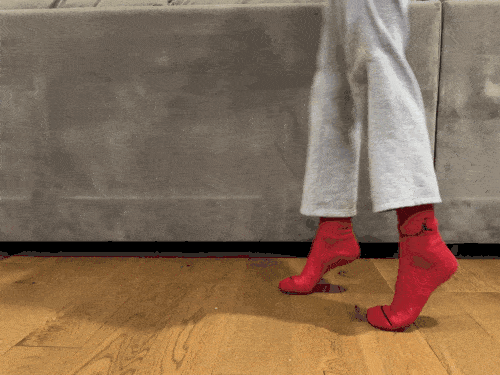
The frequency that a child walks on their toes can vary, along with how far they are on their tip toes, but any consistent walking in this way is considered toe walking.
In some more extreme cases, kids will walk on the tops of their feet with their toes curled under (like the “knuckles” of their toes) but for this post, we are mainly referring to the position where a child walks on the front part of their foot, with their heels lifted off the ground.
When Is Toe Walking Normal?
This is the question that leaves a lot of parents confused, because it can be hard to tell if a child walking on their toes is considered developmentally normal or not.
During the early stages of mobility, babies and toddlers will experiment with movements as they are learning to balance, crawl, stand, walk, and run. These movements include toe walking, and most children will do this as they are growing through these stages.
When a child passes the toddler stage and continues to walk with this gait pattern, or has an increase in toe walking at or after this stage (sometimes called persistent toe walking), it is considered no longer developmentally typical, and most doctors and therapists will try to determine why a child is toe walking.
Why Does a Child Toe Walk?
Toe walking without a diagnosed or understood reason is called “idiopathic toe walking,” meaning it begins without an obvious reason or underlying condition.
But there are many potential causes for why a child might toe walk past the toddler stage, and why many older children continue to do it as well.
Toe Walking Reason #1: Muscle Weakness
The first cause or reason for toe walking is that a child or person has an underlying muscle weakness or neurological condition that affects strength, coordination or mobility such as cerebral palsy, duchenne muscular dystrophy, or unspecified balance or motor difficulties.
In these cases, there is a biological or anatomical reason for the toe walking.
This could be related to an inherent spasticity in the muscle tone of the body such as tightness in the glutes, achilles tendon, or calf muscles, or another reason that makes walking with a heel-toe gait pattern difficult.
Toe Walking Reason #2: Digestion
There is also some research to suggest a correlation between gastro-intestinal function and toe walking, when a child rises onto the balls of their feet due to abdominal and glute clenching. Additionally, a genetic component is suspected in some instances of toe walking, as this behavior can be seen as a pattern across families.
Toe Walking Reason #3: Retained Reflex
Toe walking can also be tied to retained primitive reflexes, specifically the tonic labyrinthine reflex (TLR) or the plantar reflex.
These reflexes impact coordination (crawling and walking), balance, muscle tone, and can have a big impact on a child’s sensory processing.
Retained reflexes are common in kids with sensory difficulties as well as those with sensory processing disorder and have a range of motor, developmental, and behavioral effects on kids.
While retained reflexes are not always to blame for things like toe walking, they are important to consider because there is a definite link between them and movement-based sensory behaviors like a child walking on their toes.
Toe Walking Reason #4: Sensory Processing
But across the board, as an OT, the most common reason I see kids toe walking is because of their sensory processing. But, even as we look at sensory as the cause of toe walking, it’s not a black and white issue.
There are many ways the sensory system could be causing or motivating a child to toe walk.

Toe Walking: The Connection to Sensory Processing
As I mentioned above, a child walking on their toes is a “sensory red flag” that can point to an underlying sensory “issue” or need.
Kids who toe walk may over-process or under-process sensations which directly impacts their ability to coordinate their body for walking and movement.
For a sensory seeker, walking on toes compresses the joints of the toes, feet, and legs (there are a lot of tiny bones in there!) which gives rich proprioceptive input to the body. For a seeker, they love the way this sensation feels so they keep doing it.
Other kids who have low registration or poor body awareness because they aren’t perceiving the proprioceptive input well, may need to walk on their toes because the feedback gives the child information about their position to the floor or ground beneath them.
Basically it helps them feel where they are walking better, without toe walking they may trip or crash into things often.
Being up on the balls of the feet and on tip toes also puts the body off balance which creates increased vestibular input to the body.
This is also motivating for the sensory seeker that loves to spin, hang upside down, or swing.
But, toe walking isn’t only the result of seeking or not enough sensory input. Some kids toe walk to avoid sensations, specifically the feeling of different textures on their feet.
Often, toe walking is the preferred way of walking for a sensory avoider.
They rise onto their toes to avoid the tactile input by decreasing the surface area their feet have with the ground. This is due to over-processing sensory input.
There is even some speculation that the visual sensory system can influence toe walking because of its role in helping us navigate our environment.
See what I mean about confusing parents here?
It’s true, toe walking can be both seeking and avoiding behavior, and can be impacted by several sensory systems. In fact, almost all sensory processing difficulties can fall on a scale that can fluctuate like this, as well as be influenced by multiple sensory systems at once.
Knowing what behavior your child is showing and why is the first step to knowing how to help.
If this is new to you, I highly recommend grabbing a seat in our free sensory processing workshop which will teach you how to identify your child’s sensory needs and how to use sensory activities to help them.
This information may leave you wondering, “does toe walking mean my kid has a diagnosis?”
Does Toe Walking Mean A Child Has Autism or Sensory Processing Disorder?
Like most sensory processing sensitivities and difficulties, there is not a black and white indication that the presence of sensory red flags like toe walking automatically mean a child has sensory processing disorder, Autism, ADHD, or any other diagnosis.
However, because of the heavy sensory component to these diagnoses, it is pretty safe to assume that kids with these diagnoses who are toe walking are doing so due to sensory processing difficulties.
If you’re concerned by your child’s toe walking, you can have them assessed by an occupational therapist to determine other areas in their life where sensory processing may be affecting their behavior and independence.
The sensory systems are very connected, and it’s rare for there to be one isolated area that is being affected, so it’s worth consulting your doctor for an occupational therapy referral if you’re seeing this in your child.
Will My Child Grow Out of Toe Walking?
Because a child walking on their toes can be very developmentally normal at different stages, it can be hard to know if persistent toe walking is enough of a concern to seek intervention.
However, prolonged walking in this way can negatively affect the musculature of the feet, ankles, and legs, which can also affect the hips, and back (remember what I said about everything being interconnected?)
If your child is toe walking past the toddler years, asking your pediatrician for an OT referral can give you peace of mind to not only address the toe walking, but to see if there are other areas that can be addressed.
While many kids do grow out of it, not all will, and beginning strategies to stop toe walking as early as possible can make a big difference.
Toe Walking Sensory Strategies
If you’ve spent any amount of time on this blog, you know that as an OT, I LOVE sensory activities. They’re the best for addressing all kinds of sensory difficulties, and kids love them because they’re fun.
Toe walking is no different, and there are tons of sensory strategies that can help regulate your sensory kid so that toe walking decreases.
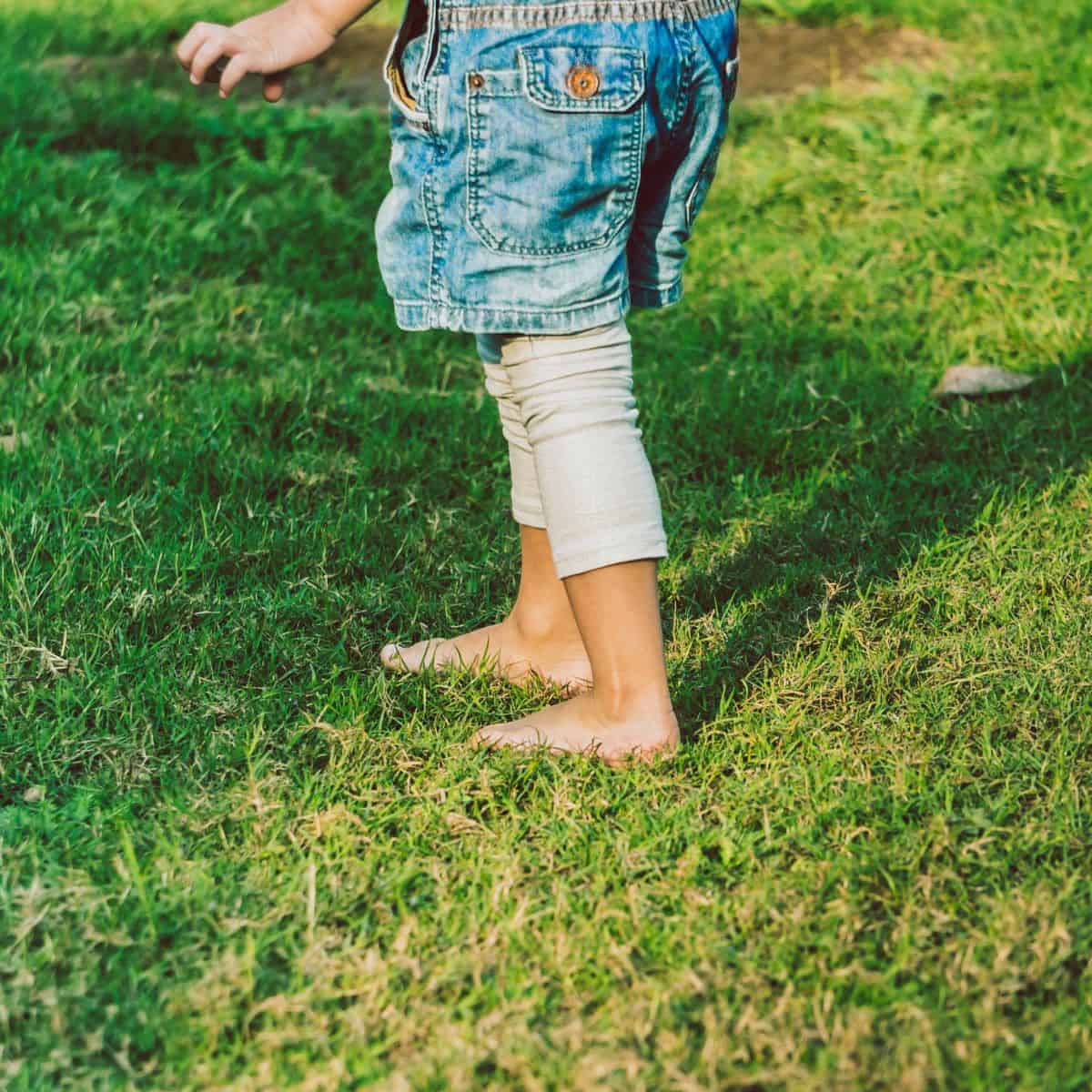
Toe Walking Sensory Strategies For Sensory Seekers
Since these kids enjoy heavy sensory input and are likely toe walking to meet these needs, think about increasing the sensations that they are getting from toe walking
- Give proprioceptive input to the feet and legs like jumping on a trampoline, crash pad, or hopping on 1 or 2 feet.
- Encourage barefoot play as much as safely possible. Even better if your child walks barefoot on different textures like grass, gravel, plush carpet, etc.
- Give massage to your child’s feet using lotions or textured washcloths
- Have child play on balance beams, stepping stones, or swings to give rich vestibular input and challenge their balance systems.
- Allow child to engage in dance, gymnastics, swim, or other activities that promote movement and coordination.
- Use joint compressions, which is often a sensory diet activity, to give very direct proprioceptive input to the joints quickly. Learn how to use joint compressions.
Toe Walking Sensory Strategies for Sensory Avoiders
These kids are over processing sensory information, so you want to work on desensitizing their sensory systems that might be encouraging toe walking.
- We talk a ton about sensory bins for all kinds of things from picky eating to texture avoidance, but did you know that you can have your child stick their bare feet in them? It sounds silly, but it’s a great way to encourage the tactile systems of the feet to process different textures.
- Gentle brushing or massage to the feet can help slowly desensitize. For very sensitive kids, begin by doing this over their socks.
- Trial different socks and shoes. A trick I learned early in my career from a pediatric physical therapist was having the child wear a rigid-soled shoe with a heel like a cowboy boot to correct gait. It works for some kids!
Toe Walking Sensory Strategies for Low Registration
- Practice “body mapping” or drawing awareness to body parts of the child, and verbally cue them to walk with a heel-toe pattern.
- Give proprioceptive input to the child (jumping, animal walks, etc.) and then have them practice heel to toe walking. You can do this with visual cues such as walking across a piece of tape, balance beam, etc.
- Use bubble wrap, tap shoes, or crumpled paper to walk over to add an auditory component to draw more attention to the exaggerated movement of walking heel to toe.
**In more severe cases of persistent toe walking where a child’s muscles or posture are negatively affected, their therapist may recommend a more drastic approach to addressing the toe walking such as serial casting, surgical interventions, or ankle-foot orthosis.
These are rare and considered only when other interventions have been unsuccessful and the therapist or doctor has deemed it medically necessary.
More Help For Sensory Toe Walking
What’s important is that if your child is consistently toe walking, you talk to your doctor about it.
There are some significant problems that can happen to muscles and joint structure from prolonged and consistent toe walking, and there are many different ways that it can be approached and worked on for your child.
If you’d like to learn more about how and when to use sensory activities, pick up our free Sensory Diet Essentials Printable that includes 25+ powerful sensory activities and template for setting them up.
Laura Mau is a licensed occupational therapist and member of the Your Kid’s Table team. She has over 8 years of clinical experience in helping families navigate complex feeding and eating, sensory processing, and reaching developmental milestones with their children. She currently practices in Colorado and has 3 young kids of her own.
Alisha Grogan is a licensed occupational therapist and founder of Your Kid’s Table. She has over 19 years experience with expertise in sensory processing and feeding development in babies, toddlers, and children. Alisha also has 3 boys of her own at home. Learn more about her here.
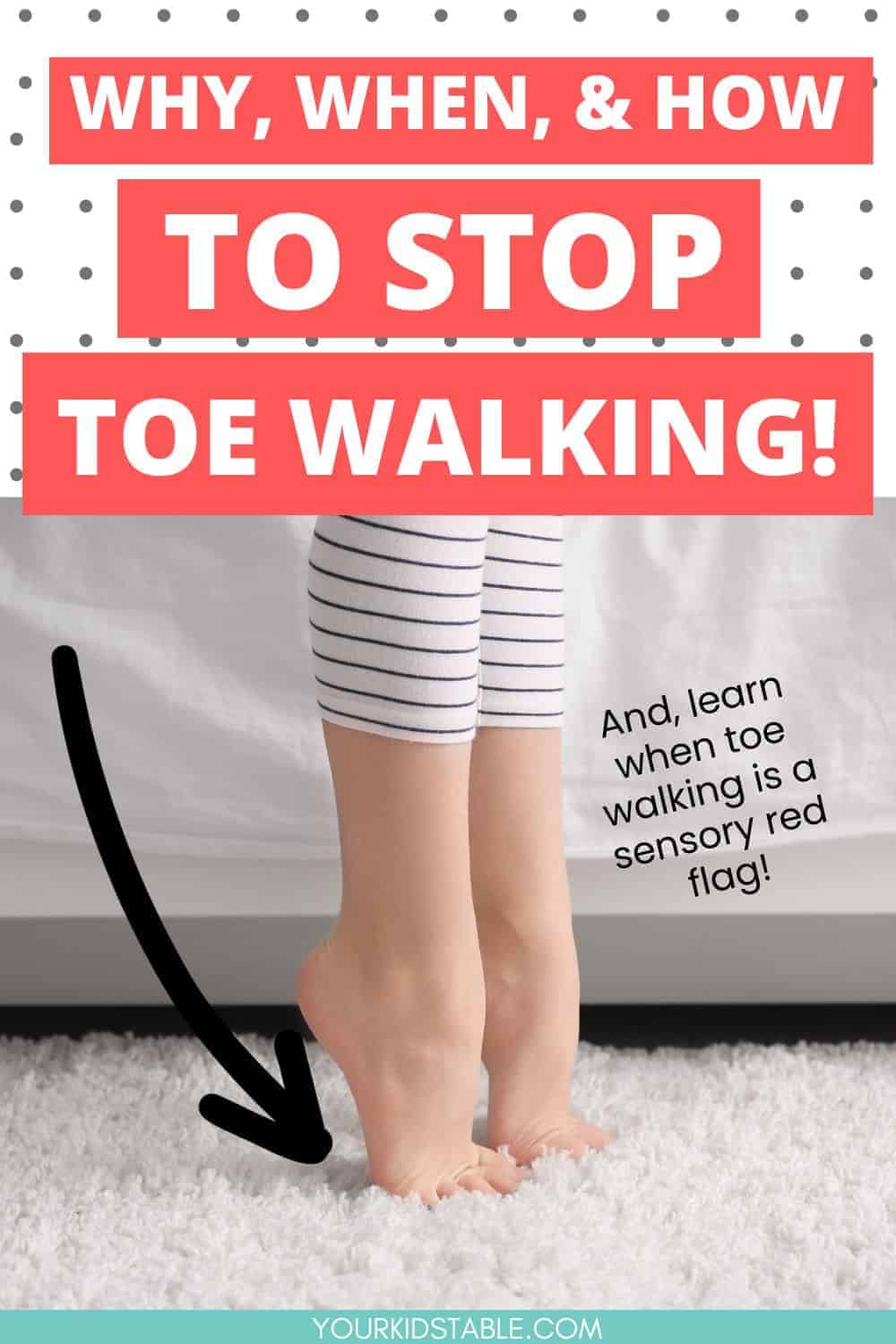
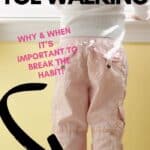
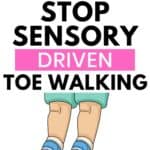
I have a 4 year old who walks on his toes very situationally. From what I observed, he does it when he’s happy, excited or over stimulated. I have integrated some proprioceptive input at bedtime but I wonder if doing it in the morning or having some quick tools for when he does it would be helpful. I just don’t want his legs to get tight. Can’t wait to try some of these suggestions!
Hi Katelynn!
You are totally thinking in the right direction. I’d add in proprioceptive input at different times of day to meet that need for him as well. I think if it’s happening situationally, he is less likely to experience as much of the biomechanical issues but adding in fun games that also promotes stretching and strengthening (like animal walks- bear and crab are some of my favorites for toe walkers) will really help!
Best,
Laura
Your Kid’s Table OT
Is there more or less concern about a 4 year old that walks on toes without shoes but walks normal when in shoes?
Hi there, great question!
This sounds like a sensory response to being barefoot or without shoes, so you could explore a tactile sensitivity. However, it’s only a concern if it is disruptive to day to day life or causing issue with any sort of safety or function. Walking normally with shoes would tell me that something is going on with the tactile sensation when shoes are off, so I’d explore that to see if you can pinpoint that a bit better!
Best,
Laura
Your Kid’s Table team member
My daughter has been wearing AFOs for over a year because of toe walking. She refused to cooperate and participate during PT. She still tip toes, and that’s with wearing AFOs. As soon as they come off she’s on her toes. She was going to OT but stopped because she wasn’t really benefiting from it. What else can I do for her?
Hi Adrianna,
It’s hard to say, but if the root cause of the toe walking is not due to muscular-skeletal, then the AFOs might not be impacting the toe walking itself. It might be related to a sensory aspect or something else. I would pursue some of those instead and see how it goes. Things like heavy proprioception to her toe joints and tactile stimulation to her bare feet to see if she enjoys that. As with any sensory input, do not force these things. If you can try sensory bins, see if she will let you bury her feet in deep things like bird seed, rice, etc.
I hope some of this helps!
Best,
Laura
Your Kid’s Table team member
why not just tell them to stop everytime? use negative discipline and time outs, every – single – time. its no different than any other unwanted childish behavior.
be the parent already.
Hello,
While this works in “theory,” if you read the article you will find that there are many reasons why Kid’s do this, including physical reasons, neurological, and developmental- all of which are not choices the child is making. Negative discipline is not linked to effective outcomes in these instances. Time outs are another can of worms that you can research the effectiveness yourself if you’re interested.
Best,
Laura
Your Kid’s Table team member
This is very insightful Laura. As an OT who recently started working with children who toe-walk, it’s very good to learn different strategies which help address this phenomenon. Thank you very much Laura
So glad to hear it Leslie! I think the “idiopathic” part really throws people off but there is almost always one or more underlying causes to everything as we know, so it’s helpful to use that lens with our toe walkers, too. Thanks for reading!
Laura
Your Kid’s Table OT
I’m retired as a health visitor but soon to open a preschool abroad. I had parents who had children who tiptoed. Not much information I came across on the subject. Thank you fir the insightful information. Stay Blessed.
Hi Margaret,
You’re very welcome! Good luck on the new adventure with the preschool! Stick around and let us know how it goes!
Best,
Laura
Your Kid’s Table OT
Great suggestions! I have a toe walker at my house, so I will be trying these out! Thanks for sharing. I’ll share this resource with my email list as well. 🙂
Hi Jami,
Thanks so much for reading and sharing! Let us know what you think after trying!
Best,
Laura
Your Kid’s Table team member
Thx u medam
As a PT this is the first time that I’ve heard of a connection between the digestive system and toe walking. I just performed a quick search and didn’t find any articles. Do you have a citation or two that you’re willing to share?
Thank you for sharing this guide, it has alot of helpful information and is easy to follow.
Hi Lisa,
Thanks so much for reading- we love fellow therapists as part of this community! There is a lot out there on the link between kids with SPD and digestion issues, often having to do with picky or restricted eating. There are new investigations being done on whether chronic constipation/impacted stools and the clenching of the abdominal muscles and then glutes causes some children to rise up on their toes or have an altered gait.
These sources touch on this connection:
https://journals.lww.com/jaaos/fulltext/2022/11150/idiopathic_toe_walking__an_update_on_natural.7.aspx
https://pubmed.ncbi.nlm.nih.gov/26709689/
https://epidemicanswers.org/symptoms_and_diagnoses/toe-walking/
Best,
Laura
Your Kid’s Table team member